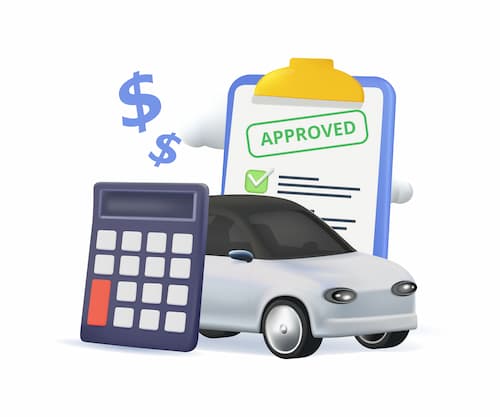Steps to transferring your insurance to your new car
Before you go car shopping, make sure you know what you need to do to transfer the insurance coverage. If you find the perfect car, you'll want to know how to get it covered quickly.
Contact your insurance company as soon as possible
Let your insurance provider know as soon as you can about your new purchase. You can do that online or through a mobile app at any time of day, or call your insurer. Companies have different grace periods to insure the new vehicle, which also depend on the state in which you live. This period can range from a few days to nearly a month.
“Typically, drivers have about 30 days to switch their insurance from their old vehicle to a new vehicle,” says Lauren McKenzie, an agent with A Plus Insurance in Liberty, South Carolina. “However, keep in mind if you are needing different coverage on the newer vehicle, it may not be included in your policy.”
There is no reason to wait, as you want to avoid the potential costs of an accident or other damage during this time to protect your investment. Also, the insurance company will backdate any new charges to the time of your new purchase, so waiting doesn't save you any money.
Review your old policy
Check your old car insurance policy to see which coverages you currently have. Keep in mind that if you financed your vehicle, your lender will require you to purchase full coverage, including comprehensive and collision.
“If you own an older vehicle which just has liability, only the liability will transfer to the new vehicle. You will need to add full coverage to that new vehicle as soon as possible in order to be properly covered,” McKenzie says.
A new model or “high-theft” vehicle is more expensive to protect, and your premiums will go up. If you’ve had any traffic violations or your address has changed, your rates can also shift. If you currently have only the state minimum, your old policy may not be enough coverage, especially if you are taking out a loan or lease.
“If you had dropped down to liability coverage only on your old car, expect to pay a good $500-$1,000 more per year on your insurance,” says Christopher J. Marquette, a Grover Hermann Professor of Business at Millikin University.
This is an excellent time to shop around for the best deal and ask about discounts.
You may be able to bundle your home and auto together for savings if they haven’t already. Or, you can use a reliable online auto insurance rate comparison tool and buy policies online.
If you’re taking out a loan, find out what’s required
If you’re taking out a loan, the financing company will require comprehensive and collision coverage. Your new vehicle is collateral for the loan, so most lenders require full coverage insurance. The same goes for leased cars.
The financing company, whether it's the car dealership or your local credit union, will tell you what's needed before allowing you to drive the car off the lot.
The insurance company will want specific details on the vehicle, its safety features, where it will be garaged and the loan details from the lienholder.
“Other important facets are knowing the VIN number, the names of all family members who may be regular drivers and any special driving circumstances you have such as using your vehicle for ridesharing,” says Marquette.
You'll also need to provide the lender's information to your insurance company to have it listed on your policy.
Understand your coverage options
Every state has a legal minimum amount of car insurance, but that doesn’t mean you should choose the rock bottom coverage option. Legal minimums don’t protect your car from damage– they only pay for damage to another person’s vehicle, property or medical bills. And they are rarely enough coverage for even a moderately serious accident.
Be sure to consider the out-of-pocket costs of an accident or other damage without comprehensive and collision coverageCollision coverage helps pay for repairs or replacement of your car if it's damaged in an accident, regardless of who is at fault and is subject to a deductible.. What seems like savings now can end up costing you much more in the event of an accident.
Some policies provide a rental if your car is in the shop, and some have roadside assistance options. You can investigate these features if you’re already reviewing your coverage.
Types of coverage refresher:
- Minimum coverage (different in each state): Liability for bodily injury and property damage to another party
- Comprehensive: Weather-related damage, vandalism, theft, glass damage, hitting a deer
- Collision: Repairs or replacement of vehicle after a collision with another car or object
- Other insurance required in a handful of states: PIP, MedPay, uninsured motorist coverage
What if this is my first car purchase?
If this is your first car purchase and the title will be in your name only, you will need your own new car insurance policy.
“If you’ve been on an insurance policy for at least six months, switching to a policy all on your own will be a little cheaper since you will have a continuous insurance discount applied on the new policy,” McKenzie says.
If a parent or guardian is the owner or co-owner of your new vehicle, you may be able to retain the same policy.
“Most family plans are multi-vehicle, usually covering up to 5 automobiles per family,” Marquette says.
You can contact the same insurer that handles your family’s plan or spend a little extra time in the dealership's finance department – they often have an insurance agent who can help you right then and there. You will need all the same basic info.
Can I transfer insurance on a weekend or holiday?
If you buy a car outside of business hours, you don't need to worry about coverage. You'll automatically be covered until you can make the change. However, if your insurer has a 24-hour customer service line or allows you to make changes online or through the mobile app, you can complete the change at any time.
You'll just need the VIN of the new vehicle and the lender information, if any, to add to the updated coverage.





